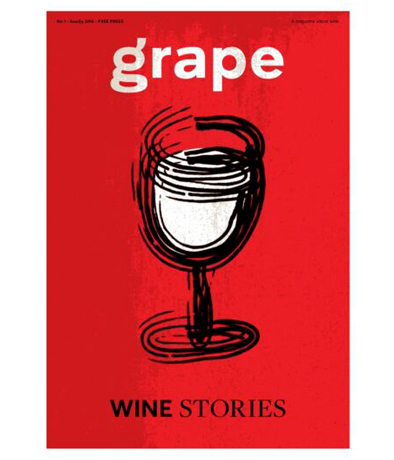
What grows best in a land of plenty? Assyrtiko could be the obvious answer, a variety considered Greece’s great gift to the world.
Assyrtiko is the base material for many of the country’s greatest wines, including wines from the volcanic terroir of Santorini, ones that definitely stands at the pinnacle of the Greek wine industry.
It’s a grape that combines dense texture and powerful character with an alluring saltiness (“guided by rocks”, I usually write in my notes…) and a razor sharp acidity that makes its wines stand out among the greatest varietals of the world. It’s the one grape that launched the worldwide discussion about Greek wine, the one that managed to cross borders with its unique and inherent qualities, a true blessing in a warming climate.
Yet Greece is a true cornucopia of genetic material, an inexhaustible collection of historically significant and, in certain cases, increasingly rare grape varieties. You just need a 20-minute drive from downtown Athens to reach a hardy patch of head-trained vines of Savatiano to verify this fact. Greece grows a significant number of exciting varieties in all its corners. As tempting as it is to dismiss these grapes in front of the “king” (Assyrtiko), they are important here, too, having been grown in their places of origin for centuries. No one can refer to the revolution that is quickly
making Greece one of the world’s most fascinating wine countries without taking into consideration all these grape varieties that stand at the heart of this change. They comprise fundamental materials for a talented generation of pioneering producers who craft fascinating wines – tributes to the great value of the diverse Greek terroirs, the country’s longstanding vinicultural traditions and the uniqueness of the Greek vineyard.
Next time you head to the Prowein, Vinitaly, or Vinexpo exhibitions, or simply to your local wine market (the one that offers a lovely selection of Greek wines), take a minute before you grab your favorite bottle of Assyrtiko to explore the other choices available. To say that Greek wine is only about Assyrtiko is like eating the same food every day in a restaurant that offers a variety of excellent dishes. And if you don’t have a clue as to where to start, take a look at the following introduction to just a few of Greece’s up-and-coming, tonguetwisting grape varieties with some winemaker’s names worth remembering as well. Keep in mind that there are many more grape varieties and producers to explore. You just need to be a bit more adventurous; you won’t regret it!
This one’s definitely the “new kid on the block” in terms of exciting varietals. Almost extinct 30 or so years ago, Malagousia today is the personification of the way that Greek producers are rediscovering their traditions. It is hugely successful, and appeals thanks to its fragrant aromatic profile, reminiscent of stone fruits and white flowers. It’s an incredibly easy-drinking wine. You can also find a herbal note, especially from cooler or earlier-harvested grapes, that gives a lovely uplift to the grape’s moderate acidity. If you have a thing for aromatic grapes such as Sauvignon Blanc or Albarino, this is your thing from Greece to try. For an irresistibly classic fragrant example, look to Ktima Gerovassiliou, which pioneered the grape’s revival; an equally delicious, more restrained mineral version is made by Domaine Zafeirakis in Tyrnavos, Central Greece.
An “ode” to Greece’s mountainous territory, Roditis is another prolific Greek variety that finds its archetypal expression in the mountainous parts of Achaia in the Peloponnese. The slopes surrounding the region of Aigialeia are the perfect spot for cultivating this pink-skinned grape if you’re interested in crafting fine, mineral and energetic wines, full of bright and vibrant lemony fruit expressions and with laser-sharp high acidity levels. Fresh styles are back in fashion and, at its best, Roditis can provide exactly that. Pair the grape with classic bush vines, extremely poor rocky soil, and high elevations, and you’ll taste one of Greece’s most interesting and contemporary styles of wine.
A few years in the bottle will develop a lovely honeyed mineral character and extra layers of complexity. Tetramythos Winery is a pioneer of this grape, making excellent white and orange Roditis with minimal intervention from grapes sourced from high-elevation vineyards. Sant’ Or is a personal favorite, especially after a couple of years in the bottle; it has a complex mineral-driven character. The classic Asprolithi Roditis from Rouvalis Winery is the absolute value-for-money expression of the grape, a real steal considering its quality.
All it took was a young generation of winemakers, mainly from the region of Attica, this variety’s traditional home, to embrace the local fondness for Savatiano and give it the attention that it required. This is a prolific grape variety that once found its place as an essential ingredient in Greece’s most traditional wine, retsina. It still does service there, but Savatiano can be an absolute bliss when in the right hands, treated with great care and planted in the limestone soils of Attica, where old gnarled head pruned vines predominate. Under such conditions, It restricts its yields, concentrates its flavors and shines in all its aspects. The wines are relative fruity, far less obtrusive than more aromatic grapes such as Malagousia, and are built on texture rather than on acidity or freshness.
With just a few years of aging, they develop a lovely honeyed, toasted character. I cannot think of a grape that better represents the transition to the new era of Greek wine. A generation of producers such as those at the wineries of Papagiannakos, Mylonas, Anastasia Fragou, and Aoton are redefining the conversation around this grape, improving upon the past and repairing the wrongs of previous generations, without losing respect for tradition. It is, in short, as simple as that.
Crete, the southernmost part of Greece, has a compelling story of its own; furthermore, being such a large island (the fifth largest in the Mediterranean), it can offer a variety of very interesting terroirs and styles of wine. It boasts a multitude of autochthonous white and red grape varieties, but Vidiano, a white variety, is its undisputable “diva”, a grape that has earned its place as the island’s leader. It has, in the relatively recent past, also been planted in other parts of Greece.
It is genuinely expressive, floral, and boasts a ripe fruit character, with lovely density and a typically creamy texture often enhanced by contact with oak barrels. Lyrarakis Winery and Douloufakis Winery are standard-bearers, both offering exciting expressions of the grape. At the winery that bears her name, Iliana Malihin and her promising project of seeking out old ungrafted organic vineyards in the grape’s homeland of Rethymnon may just takes this grape to a whole different level, adding a further chapter to the great story of this wonderful variety.
Hailing from the extremely rocky soil of the slopes of Mt Aenos in Kefalonia, on the far side of western Greece, this is a grape variety rarely seen outside its homeland. The wines are minerally driven, moderately aromatic and fresh in their youth, like “baby Assyrtiko”, developing a distinct petrol-like minerality and complexity after a few years of aging. Very capricious, both in the vineyard and the winery, this is a grape capable of offering different styles.
From the slightly riper fruit and the broader texture of Vino di Sasso Robola from Sclavos Winery (pioneers of the natural movement in Greece) to the more mineral, energetic and high-acid version from the Gentilini Winery and Vineyards, Robola is utterly delicious and terroir-sensitive. If you’re a fan of Chablis or Sancerre, you will love these wines. The local cop of the region is another excellent producer, alongside with Petrakopoulos Wines and Sarris Winery; the latter’s Panochori label, from extremely old vineyards growing on dizzyingly steep slopes is a phenomenal expression of the grape.
Anyone could be forgiven for being overwhelmed by the numerous indigenous varieties found in Greece. The hard-to-pronounce pink-skinned Moschofilero, however, should be on your radar; it’s an important grape from Mantinia in the Peloponnese. The grape’s beauty derives from its fragrant, fruity and floral aromatic character, reminiscent of rose petals, and from its cool-climate textured palate, bursting with elegance, freshness and lightness. The development in styles is fueling the market with some of the most exciting wines that Greece has to offer.
From the still and sparkling classic expressions of classic producers such as Tselepos, Spiropoulos and Semeli to the new wave of innovative styles (pet nats, long-macerations, low-intervention wines, and rosés), the range adds to the interest that this grape is generating. The wineries of Troupis, Bosinakis, and Moropoulos, along with the Panagopoulos Estate, are all relative newcomers that are worth seeking out.
Known for its exquisite sweet fortified wines, the red Mavrodaphne grape is now being explored from a different angle, being increasingly vinified for the production of dry reds. Dense aromas of prunes, blackcurrants and angelica flowers, and an equally dense palate, with a characteristic finish that’s slightly bitter, are among its excellent attributes. The winds of change and the new thirst for dry wines means that this grape is increasingly vinified to dry, with lots of experimentation from the producers. Kefalonia and the western Peloponnese are natural homes for this fantastic grape, which produces wines with balance, unique perfumes and a refined structure.
Strangely enough, because of a deeply conservative streak in Greek bureaucracy, the name of the grape variety cannot appear on the labels of dry wine styles. Look instead for such innovative names on the shelves as Sclavos Monambeles, densely dark-fruited from century-old vines, or the single vineyard Rouvalis Tsigello Dafnes, a perfect example of the grape’s combined power and elegance. Parparoussis Winery, Petrakopoulos Wines, Haritatos Vineyard and, of course, Achaia Clauss are just a few more of the many names that excel when it comes to this grape.
As the largest of the Greek islands, Crete is home to several of the country’s indigenous varieties. I’ve already spoken of Vidiano, the great Cretan white variety; Liatiko is the leading red grape of the island, with many ungrafted old vines still present in the vineyard. The best examples take full advantage of the hot and dry climate of Crete. The pale colour, with a dry sensation on the palate, and the slightly rustic, yet elegant, tannins are characteristic, as is a unique flavor profile reminiscent of dried and red fruits and developing layers of herbal complexity and earthiness. Smelling these wines transports you immediately
to their place of origin; each glass is a burst of aromas with an alluring texture of great harmony. Domaine Economou, in the far eastern corner of the island, sets the benchmark for this variety; their “Antigone” is a phenomenal 20-year-old wine of unrivaled subtlety, finesse and depth that reminds one of a grand cru from Burgundy. Winemakers Douloufakis and Diamantakis are also doing outstanding work with this fantastic grape.
Definitely a rising star of the Greek vineyard, Limniona delivers wines of lovely purity, with crunchy red-fruit aromas, such as cranberry and cherry, alongside some peppery and floral notes. Especially with the younger wines, it’s like walking in a garden full of roses.
The palate is very elegant, with fine tannins and a great drinkability. Stylistically, this grape is the definition of elegance, not only with its wonderful nose and ethereal character but also with its silky texture. Domaine Zafeirakis wrote this grape’s comeback story, rescuing the variety from extinction. Oenops Wines, Dougos Winery and Domaine Karanika are other names to keep in mind.
Με την εγγραφή σας στη λίστα των παραληπτών θα λαμβάνετε το newsletter του grape!





Με την εγγραφή σας στη λίστα των παραληπτών θα λαμβάνετε το newsletter του grape!